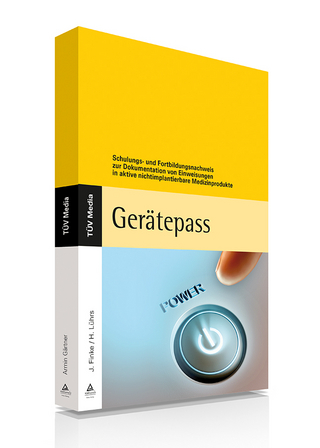
Sterilisation of Biomaterials and Medical Devices
Woodhead Publishing Ltd (Verlag)
978-1-84569-932-1 (ISBN)
The effective sterilisation of any material or device to be implanted in or used in close contact with the human body is essential for the elimination of harmful agents such as bacteria. Sterilisation of biomaterials and medical devices reviews established and commonly used technologies alongside new and emerging processes.
Following an introduction to the key concepts and challenges involved in sterilisation, the sterilisation of biomaterials and medical devices using steam and dry heat, ionising radiation and ethylene oxide is reviewed. A range of non-traditional sterilisation techniques, such as hydrogen peroxide gas plasma, ozone and steam formaldehyde, is then discussed together with research in sterilisation and decontamination of surfaces by plasma discharges. Sterilisation techniques for polymers, drug-device products and tissue allografts are then reviewed, together with antimicrobial coatings for ‘self-sterilisation’ and the challenge presented by prions and endotoxins in the sterilisation of reusable medical devices. The book concludes with a discussion of future trends in the sterilisation of biomaterials and medical devices.
With its distinguished editors and expert team of international contributors, Sterilisation of biomaterials and medical devices is an essential reference for all materials scientists, engineers and researchers within the medical devices industry. It also provides a thorough overview for academics and clinicians working in this area.
Sophie Lerouge is Professor of Mechanical Engineering at the École de technologie supérieure, Adjunct Professor in the Department of Radiology at the University of Montreal, and researcher at the University of Montreal Hospital Research Center (CRCHUM), Montreal, Canada. Anne Simmons is Professor of Mechanical and Manufacturing Engineering at the University of New South Wales, Australia.
Contributor contact details
Woodhead Publishing Series in Biomaterials
Chapter 1: Introduction to sterilization: definitions and challenges
Abstract:
1.1 Introduction
1.2 Definitions of sterilization in the context of biomaterials
1.3 Validation, monitoring and safety of sterilization methods
1.4 Challenges and constraints of sterilization methods
1.5 Ideal versus actual sterilization methods
1.6 Conclusions
Chapter 2: Steam and dry heat sterilization of biomaterials and medical devices
Abstract:
2.1 Introduction
2.2 Steam sterilization
2.3 Different methods of steam sterilization
2.4 Test methods for the effectiveness of steam sterilization
2.5 Dry heat sterilization
2.6 Testing and validating dry heat sterilization
2.7 Conclusions
Chapter 3: Sterilisation of healthcare products by ionising radiation: principles and standards
Abstract:
3.1 Introduction
3.2 Interaction of ionising radiation with matter
3.3 Sources of ionising radiation
3.4 Validation and international standards of sterilisation by ionising radiation
3.5 Conclusions and future trends
3.6 Sources of further information and advice
Chapter 4: Ethylene oxide (EO) sterilization of healthcare products
Abstract:
4.1 Introduction
4.2 Advantages of ethylene oxide (EO) sterilization
4.3 Disadvantages of ethylene oxide (EO) sterilization
4.4 Sterilization process characterization
4.5 Process definition
4.6 Process optimization and the process challenge device
4.7 Qualification of ethylene oxide (EO) sterilization
4.8 Contract sterilization
4.9 Acknowledgments
Chapter 5: Non-traditional sterilization techniques for biomaterials and medical devices
Abstract:
5.1 Introduction
5.2 Non-traditional sterilization methods
5.3 Novel non-traditional sterilization methods
5.4 Conclusions
Chapter 6: Sterilization and decontamination of surfaces by plasma discharges
Abstract:
6.1 Introduction
6.2 Overview of plasma generation
6.3 Plasma generation at low and atmospheric pressures
6.4 Interaction of plasma with biological pathogens: bacteria and bacterial spores
6.5 Interaction of plasma with biological pathogens: pyrogens and proteins
6.6 Further issues with the use of plasma for sterilization purposes
6.7 Conclusions and future trends
Chapter 7: Sterilisation techniques for polymers
Abstract:
7.1 Introduction
7.2 Dry-heat sterilisation
7.3 Steam (moist heat) sterilisation
7.4 Ethylene oxide (EO) sterilisation
7.5 Low-temperature hydrogen peroxide with plasma
7.6 Ozone sterilisation
7.7 Radiation sterilisation
7.8 Sterilisation and polymer efficiency
7.9 Comparative efficiencies of sterilisation techniques for different polymers
7.10 Post-implantation effects
7.11 Dry heat sterilisation of silicones
7.12 Ethylene oxide (EO) sterilisation of polymers
7.13 Sterilisation issues relating to biodegradable polymers and coatings
7.14 Biocompatibility testing5
7.15 Conclusions
Chapter 8: Sterilisation of healthcare products by ionising radiation: sterilisation of drug-device products and tissue allografts
Abstract:
8.1 Introduction
8.2 The effect of radiation on aqueous systems
8.3 Sterilisation of aqueous solutions of proteins and enzymes: reactions of free radicals with proteins
8.4 The sterilisation of proteins in aqueous solution
8.5 Sterilisation of drugs using radiation
8.6 Sterilisation of drug-delivery systems using radiation
8.7 Sterilisation of tissue allografts using radiation
8.8 Conclusions and future trends
8.9 Sources of further information and advice
Chapter 9: Antimicrobial coatings for ‘self-sterilisation’
Abstract:
9.1 Introduction
9.2 Self-sterilising surfaces
9.3 Antimicrobial metal surfaces
9.4 Light-activated antimicrobial surfaces
9.5 Conclusions
Chapter 10: Prions and endotoxins: reprocessing strategies for reusable medical devices
Abstract:
10.1 Introduction: prion disease epidemiology
10.2 Prion resistance to inactivation: early research
10.3 Current recommendations for instrument reprocessing
10.4 Factors that impact the decision to use prion-inactivating methods
10.5 Important issues associated with cleaning/decontamination
10.6 Research developments towards a validated reprocessing strategy
10.7 Bacterial endotoxins
10.8 Device reprocessing strategies for endotoxin
Chapter 11: Future trends for the sterilisation of biomaterials and medical devices
Abstract:
11.1 Introduction
11.2 Common sterilisation techniques
11.3 Future trends
11.4 Conclusions
Index
| Reihe/Serie | Woodhead Publishing Series in Biomaterials |
|---|---|
| Verlagsort | Cambridge |
| Sprache | englisch |
| Maße | 156 x 234 mm |
| Gewicht | 670 g |
| Themenwelt | Medizin / Pharmazie |
| Technik ► Medizintechnik | |
| ISBN-10 | 1-84569-932-7 / 1845699327 |
| ISBN-13 | 978-1-84569-932-1 / 9781845699321 |
| Zustand | Neuware |
| Haben Sie eine Frage zum Produkt? |
aus dem Bereich
